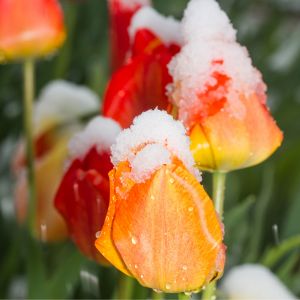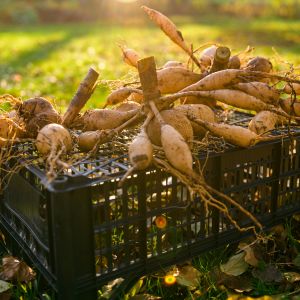Shhh! Don’t say it. You know, the F word! No, not that F word, the gardening F word: FROST! There aren’t many other words that a gardener hears that invoke such panic. In the spring, when the F word is mentioned, you may see neighbors frantically covering their tender annuals with sheets. During the fall gardening season, frost takes on a whole new meaning. If the gardening F word scares you, keep reading to find out how frost may impact flower bulbs.
The Impact of Frost on Flower Bulbs
Spring Frost and Flower Bulbs
Frost can impact flower bulbs in both spring and fall. However, the impact is different in each season. In the spring, tender bulbs are susceptible to frost if planted too early or a rare late-season frost arises. Tender bulbs, also called summer flower bulbs or spring-planted bulbs, are frost-sensitive. They are dahlias, calla lilies, canna lilies, begonias, caladiums, and specialty bulbs from tropical and temperate climates. To avoid frost damage to tender bulbs during the spring planting season, it is best to wait until the last average frost date in your area before planting. By waiting to plant, you can largely reduce the risk of frost damaging tender bulbs in the spring.
 During the spring months, a concern from gardeners is when an early frost occurs and their tulips and daffodils have emerged. Typically, a frost and even a light layer of snow will cause zero to minimal damage to newly emerging spring-blooming bulbs. Spring-blooming bulbs like tulips, daffodils, hyacinths, and crocus are native to cold mountainous areas. They are quite resilient when cold weather appears in early to mid-spring. Therefore, if a frost warning pops up in spring and your bulbs have emerged, no need to fret; the bulbs know what to do to survive.
During the spring months, a concern from gardeners is when an early frost occurs and their tulips and daffodils have emerged. Typically, a frost and even a light layer of snow will cause zero to minimal damage to newly emerging spring-blooming bulbs. Spring-blooming bulbs like tulips, daffodils, hyacinths, and crocus are native to cold mountainous areas. They are quite resilient when cold weather appears in early to mid-spring. Therefore, if a frost warning pops up in spring and your bulbs have emerged, no need to fret; the bulbs know what to do to survive.
If frost damage does occur on spring blooming bulbs, it is often minimal. Unfortunately, there really isn’t much that can be done to prevent frost damage to newly emerging bulbs. If you want to be overly cautious, you may cover the emerging bulbs with a bed sheet.
Fall Frost and Tender Bulbs
 Frost can impact tender bulbs in the fall months. Frost that happens in the fall months can be fatal for tender bulbs, especially when it is considered a “killing frost.” A “hard frost or killing frost” occurs when temperatures are lower than 28 degrees. This will most likely result in the bulbs being damaged beyond repair if they aren’t protected. When a hard frost or killing frost is predicted, it is best to remove the bulbs from the ground and prepare them for storage indoors. Check out this helpful article on How to Store Summer Bulbs to prepare for a hard frost and winter storage.
Frost can impact tender bulbs in the fall months. Frost that happens in the fall months can be fatal for tender bulbs, especially when it is considered a “killing frost.” A “hard frost or killing frost” occurs when temperatures are lower than 28 degrees. This will most likely result in the bulbs being damaged beyond repair if they aren’t protected. When a hard frost or killing frost is predicted, it is best to remove the bulbs from the ground and prepare them for storage indoors. Check out this helpful article on How to Store Summer Bulbs to prepare for a hard frost and winter storage.
A light frost and patchy frost may kill off the top portions of tender bulbs, but it most likely won’t damage the underground bulbs initially. If multiple light frosts happen, this could indicate trouble for the tubers, as the moisture from the frost on the ground could cause rotting underground. However, just one or two sporadic nights of light frost should not cause any major damage to tender bulbs.
Fall Frost and Fall Flower Bulb Planting
Planting flower bulbs in the fall is one of the most common gardening activities. There seems to be a lot of confusion around frost and how it relates to planting flower bulbs in the fall. When a frost warning is declared on the local news, it may bring feelings of panic and worry to those who have not yet planted their tulips and daffodils. Gardeners may think once the first frost happens that it’s too late to plant popular fall bulbs like tulips and daffodils. That couldn’t be further from the truth, and gardeners should know there is still plenty of planting season left after the first frost.
 The first frost occurrence is an indication that it is prime planting time for fall flower bulbs. Tulips, daffodils, and the rest of the fall-planted bulbs do best when planted during cool temperatures. The best time to plant these types of bulbs is when the daytime temperatures are in the 60’s or lower on a regular basis. Typically, once the first frost has occurred, these temperatures become regular, and planting conditions are ideal.
The first frost occurrence is an indication that it is prime planting time for fall flower bulbs. Tulips, daffodils, and the rest of the fall-planted bulbs do best when planted during cool temperatures. The best time to plant these types of bulbs is when the daytime temperatures are in the 60’s or lower on a regular basis. Typically, once the first frost has occurred, these temperatures become regular, and planting conditions are ideal.
What about planting after a killing frost? Is it too late then? Most likely no; it isn’t too late once a killing frost happens. It takes several days and even weeks of regular below-freezing temperatures for the ground to freeze solid. For fall-planted bulbs, if the ground can be dug into it is safe to plant. Therefore, most areas, even colder hardiness zones like zone 5, have through mid-to-late November to plant, and sometimes even into December.
Don’t Panic, It’s Just a Little Frost
A little frost most likely won’t thwart your flower bulb plans in spring or summer. However, paying attention to local weather is always helpful when planning for a successful flower garden. Therefore, to avoid having the scary F word FROST cause damage, follow some simple tips. In spring, avoid being hasty with early-season planting. It’s best to wait until the danger of frost has passed. In the fall, pull tender bulbs before the first major frost occurs to be extra safe. Know that if frost is predicted or has occurred, as long as the ground can be dug into, there is still time to plant bulbs for spring blooms!
Learn More About Planting Time Frames for a Successful Flower Garden


